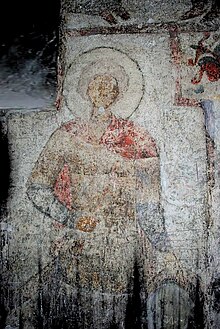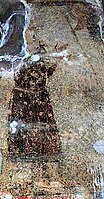Zakare III Zakarian
Zakare III Zakarian Զաքարիա Գ Զաքարյան | |
|---|---|
 | |
| Amirspasalar | |
| In office 1250–1261 | |
| Preceded by | Avag Zakarian |
| Succeeded by | Ivane III Abuletisdze |
| Personal details | |
| Born | Unknown |
| Died | 1261 |
| Resting place | Kobayr monastery |
| Spouse | Sargis I Jaqeli's daughter |
| Parent | Shahnshah Zakarian |
| Military service | |
| Battles/wars | Siege of Baghdad |
Zakare III Zakarian (Armenian: Զաքարիա Գ Զաքարյան; Georgian: ზაქარია III მხარგრძელი, romanized: zakaria III mkhargrdzeli) (died 1261 AD) was a 13th century Armenian noble and a Court official of the Kingdom of Georgia, holding the position of amirspasalar (Commander-in-Chief) for the Georgian army.
Family
[edit]He was a son of the noble Shahnshah Zakarian, and a member of the Zakarid dynasty. He was married to daughter of Sargis I Jaqeli, duke of Samtskhe. He was one of the main Greater Armenian lords to implement the alliance between his suzerain the Georgian King David VII and the Mongol Prince Hulegu, during the Mongol conquest of Middle East (1258-1260).[2] Others included the Georgian leader Hasan Brosh, Prince of Kakheti and son of Vasak Xaxbakean, and Sevadin, son of Grigor Xachenac'i.[3][4]

Biography
[edit]King David VII made Zakare, son of Shahnshah Zakarian, an escort for his journey to Karakorum, where Zakare attended on an official recognition of David by Güyük Khan. According to the 13th century historian Juvayni:
From Khitai there came emirs and officials; and from Transoxiana and Turkestan the emir Masʿud accompanied by grandees of that region. With the emir Arghun there came the celebrities and notables of Khorasan, Iraq, Lur, Azerbaijan and Shirvan. From Rum came Sultan Rukn al-Din and the Sultan of Takavor (Trebizond); from Georgia, the two Davits; from Aleppo, the brother of the Lord of Aleppo; from Mosul, the envoy of Sultan Badr al-Din Luʾluʾ; and from the city of Peace, Baghdad, the chief qadi Fakhr al-Din. There also came the Sultan of Erzurum, envoys from the Franks, and from Kerman and Fars also; and from ʿAla al-Din of Alamut, his governors in Quhistan, Shihab al-Din and Shams al-Din. And all this great assembly came with such baggage as befitted a court; and there came also from other directions so many envoys and messengers that two thousand felt tents had been made ready for them: there came also merchants with the rare and precious things that are produced in the East and the West.
Siege of Baghdad (1258)
[edit]
In 1258, Zakare participated in the Siege of Baghdad organized by Hulegu Khan, together with Prince Prosh Khaghbakian. They participated in the capture of the city and the massacre of its inhabitants, but the Christians were spared.[7][8][9] According to Bar Hebraeus, the Georgians, who had been recognized warriors among the Mongols since the 1240s, 'especially effected a great slaughter'.[10] From the Christian point of view, the conquest of Baghdad was considered as a "divine revenge" against the Caliphate.[7]
In 1260, Hulegu Khan requested from David VII Ulu to support him in the war against Mamluk Sultanate in Cairo. David, remembering the Georgian losses at Baghdad refused to comply and revolted against his Mongol overlord. It happened that Zakare was with Mongol general Arghun Aqa. However he went unbeknownst to Arghun to see his wife who was with her father Sargis I Jaqeli, one of the rebels. When Arghun learned about this, he notified Hulegu, who himself ordered that Zakare be taken shackled. Zakare was executed, while his father Shahnshah was freed for a ransom.[11][12]
Mural paintings
[edit]The family members of the Zakarian family, including Zakare, Ivane, Shahnshah or Khutlubuga, are thought to be depicted in the murals of the Haghpat Monastery,[13] and inside the arches at the Kobayr Monastery (1282).[14][15] Khutlubuga in particular is directly attested through an inscription and a relatively well preserved mural, renforcing the suggestion that other close members of the dynasty were also depicted with him.[16]
-
Kobayr fresco (men in uniform). Chapel
-
Probable mural of Shahnshah's wife, and Zakare III's mother.[15] Kobayr Monastery's Chapel, painted in the 1270s. .[1]
-
Kobayr mural (devotee). Chapel
Sources
[edit]- Shoshiashvili, N., Georgian Soviet Encyclopedia, vol. 7, p. 271. Tbilisi, 1979
References
[edit]- ^ a b Evans, Helen C.; Anderson, Benjamin; Aslanian, Sebouh David; Balakian, Peter; Eastmond, Antony; Jones, Lynn A.; Mathews, Thomas F.; Piñon, Erin; Qiu, Earnestine M.; Richardson, Kristina L. (10 January 2022). Art and Religion in Medieval Armenia. Metropolitan Museum of Art. pp. 48–49. ISBN 978-1-58839-737-9.
- ^ Bai︠a︡rsaĭkhan, D. (2011). The Mongols and the Armenians (1220-1335). Leiden; Boston: Brill. p. 121-129. ISBN 978-90-04-18635-4.
MONGOL-ARMENIAN MILITARY COOPERATION: STAGE I: THE CONQUEST OF THE MIDDLE EAST 1258-1260 (...) The main allies of this campaign were King Het'um from Cilicia, the Greater Armenian lords under the Georgian King David Ulu and the Mongol Prince Hűlegű, who promoted himself as a founder of the Mongol dynasty in this region.(...) In November 1257, Hűlegű set off from Hamadān in the direction of Baghdad. (...) With him were the forces of the Armenian Prince Zak'arē, the son of Shahnshah Zak'arian and Prince Pŕosh Khaghbakian. The Mongols placed considerable trust in these Armenian lords, whose assistance they had received since the 1230s.
- ^ Galstyan, A.G. (1974). "The conquest of Armenia by the Mongol armies" (PDF). The Armenian Review. Hairenik Association: 366.
Participated in the taking of Baghdad: Zakare, Shahinshah's son; Hasan Brosh, son of Vasak Xaxbakean; Sevadin, son of Grigor Xachenac'i and others . At Hulegu's order on February 1, 1258 prince Brosh Xaxbakean was sent at the head of a delegation of the Mongol command to the last Caliph of Baghdad Mu'tasim.
- ^ Grousset (1970). Empire of the Steppes--History of Central Asia. p. 356.
The Mongols, whose ranks included many Nestorians, such as the Naiman Kitbuqa (to say nothing of the Georgian auxiliaries led by Hasan Brosh, the Armeno-Georgian prince of Kakhetia), consistently spared the Christian elements in Baghdad at the time of the sack.
- ^ Дрампян, Ирина Рубеновна (1979). Фрески Кобайра (in Armenian). Советакан грох. p. 20.
Shahnshah, of the Zakarian family. Though we don't have documental informations concerning the paintings of the Aisle, the portraits of the donators whom we consider to be Shahnshah and his wife allow us to look upon the painting as one close to the date of the Big Church; the likeness in the artistic style confirms this suggestion
- ^ Eastmond, Antony (2017). Tamta's World: The Life and Encounters of a Medieval Noblewoman from the Middle East to Mongolia. Cambridge University Press. p. 348. doi:10.1017/9781316711774. ISBN 9781316711774.
- ^ a b Pubblici, L. (2023). 'Georgia and the Caucasus', in M. Biran and H. Kim (eds.) The Cambridge History of the Mongol Empire. Cambridge: Cambridge University Press. p. pp. 719–720.
The Georgian and Armenian aristocracy now was bound tightly to the Mongol leading class and the military became of primary importance. The Mongols forced their subjects to participate in their military campaigns. For the local aristocracy, it was sometimes necessary to contribute in order to get some immediate advantages from them. Therefore the intervention of Armenian and Georgian forces in Mongol military operations was not an isolated incident. (...) Around mid-1200, the whole Caucasian region was gripped by Mongol power on one side and the Muslim independent states on the other; the Ismā'īlĭs (Assassins) in the territory between Syria and northern Iran, and the Caliphate of Baghdad. When Hülegü began the military campaign against the caliphate, the Armenian and Georgian aristocracy took the opportunity to eliminate the menace and joined the Mongol armies. The attack on the Assassins' stronghold in Alamūt – which ended with the fall of the city in November 1256 – was planned and executed with the aid of David Lasha. Prince Zak'are, son of Shahanshah, participated in the operations against Baghdad in 1258 and the Armenian aristocracy was fully involved as well. Eastern Christianity embraced the conquest of Baghdad by Hülegü's army as divine revenge. The Mongols massacred the Muslim population of the city but spared the Christians. Hülegü gave the palace of the Dawādār (vice chancellor) to the Nestorian patriarch Makhika. Kirakos describes the fall of Baghdad in joyful terms and states that all the oriental Christians were exulting because after 647 years the "Muslim tyranny" had finally ended.
- ^ Bai︠a︡rsaĭkhan, D. (2011). The Mongols and the Armenians (1220-1335). Leiden; Boston: Brill. p. 129. ISBN 978-90-04-18635-4.
In November 1257, Hűlegű set off from Hamadān in the direction of Baghdad. (...) With him were the forces of the Armenian Prince Zak'arē, the son of Shahnshah Zak'arian and Prince Pŕosh Khaghbakian. The Mongols placed considerable trust in these Armenian lords, whose assistance they had received since the 1230s.
- ^ Biran, Michal (25 July 2022). Scheiner, Jens; Toral-Niehoff, Isabel (eds.). Baghdād: From Its Beginnings to the 14th Century. Leiden: Brill. pp. 285-315. doi:10.1163/9789004513372_012.
At the very beginning of 1258 Hülegü and his multi-ethnic armies—including Chinese siege breakers, Armenian and Georgian auxiliaries and quite a few Sunnī Muslim troops from Central Asia, Iran and Iraq— converged on Baghdād from all sides. Fighting began in earnest in mid-January, and the city was taken on February 10, 1258, when the caliph left the city and surrendered to Hülegü.
- ^ Eastmond, Antony (20 April 2017). Tamta's World. Cambridge University Press. p. 372. ISBN 978-1-107-16756-8.
Bar Hebraeus reports that the Georgians 'especially effected a great slaughter'. The Georgians had already gained a strong reputation for fighting among the Mongols. When the Franciscan Benedict the Pole returned from his missions to the Mongols in the late 1240s, he reported: "While they were staying there, they often met Georgians who lived among the Tartars and were highly respected by them as brave and warlike men. These people are called Georgians because they invoke St Gearge in their wars and have him as patron and honour him beyond all other saints. They use the Greek version of Holy Scripture and have crosses on their camps and carts. They follow the Greek rited in divine worship among the Tartars"
- ^ Kirakos Gandzakets‘i, 1961:391–393
- ^ Vardan Arevelts‘i, 1991:152
- ^ Hakobyan, Zaruhi A. (2021). "The Frescoes of the Haghpat Monastery in the Historical-Confessional Context of the 13th Century". Actual Problems of Theory and History of Art. 11: 264. doi:10.18688/aa2111-02-21.
Thus, it could be assumed that in Haghpat there was painted a group of patrons, besides Khutlubuga and Sadun presumably including Zakare (from the right to left), Ivane, and Shahnshah.
- ^ Hakobyan, Zaruhi A. (2021). "The Frescoes of the Haghpat Monastery in the Historical-Confessional Context of the 13th Century". Actual Problems of Theory and History of Art. 11: 264. doi:10.18688/aa2111-02-21.
In this regard, we could compare it with the other patron's composition in the small church of Kobayr (1282) with the members of Zakare family, where some of them are included inside the arches [6, pp. 12–13, fig. 34–35].
- ^ a b Дрампян, Ирина Рубеновна (1979). Фрески Кобайра (in Armenian). Советакан грох. p. 20.
Shahnshah, of the Zakarian family. Though we don't have documental informations concerning the paintings of the Aisle, the portraits of the donators whom we consider to be Shahnshah and his wife allow us to look upon the painting as one close to the date of the Big Church; the likeness in the artistic style confirms this suggestion
- ^ a b Hakobyan, Zaruhi A. (2021). "The Frescoes of the Haghpat Monastery in the Historical-Confessional Context of the 13th Century". Actual Problems of Theory and History of Art. 11: 265. doi:10.18688/aa2111-02-21.


![Probable mural of Shahnshah's wife, and Zakare III's mother.[15] Kobayr Monastery's Chapel, painted in the 1270s. .[1]](http://upload.wikimedia.org/wikipedia/commons/thumb/9/92/Kobayr_fresco_2.jpg/163px-Kobayr_fresco_2.jpg)
![Khutlubuga. Church of the Holy Sign. Haghpat Monastery, southern wall. Late 13th century.[16]](http://upload.wikimedia.org/wikipedia/commons/thumb/e/e3/Mural_representing_Khutlubuga._Church_of_the_Holy_Sign._Haghpat_Monastery%2C_southern_wall._Late_13th_century._%28color%29.jpg/122px-Mural_representing_Khutlubuga._Church_of_the_Holy_Sign._Haghpat_Monastery%2C_southern_wall._Late_13th_century._%28color%29.jpg)
